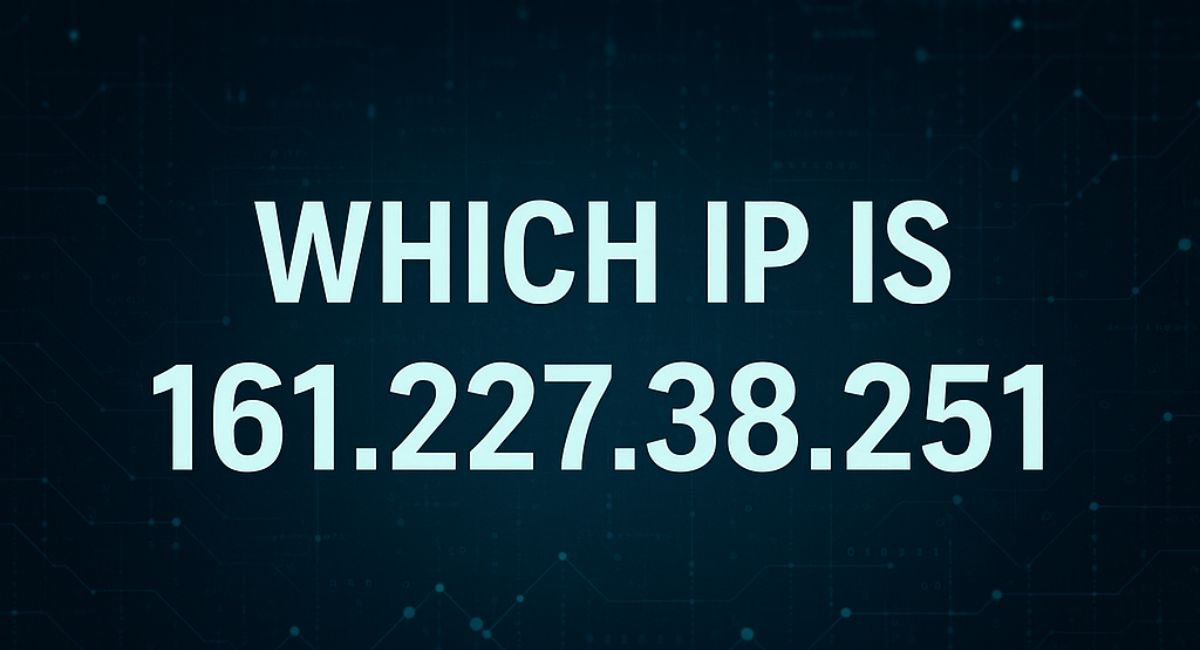1. Introduction: Which IP Is 161.227.38.251 and Why You Should Care
When you ask the question, which IP is 161.227.38.251, you’re delving into a topic that spans cybersecurity, digital privacy, and geolocation tracking. This specific IP address, like many others, can reveal surprising details about its origin and use. Whether you’re an IT professional, a website administrator, or a curious internet user, understanding IP addresses is critical. In this article, we’ll explore everything you need to know about this IP—its origin, type, associated risks, and how to trace it. The query “which IP is 161.227.38.251” is not just technical; it opens a gateway to understanding how the web works.
2. What Is an IP Address? Understanding the Basics First
Before diving into which IP is 161.227.38.251, let’s cover what an IP address actually is. An Internet Protocol (IP) address is a numerical label assigned to every device connected to a computer network. It serves two primary functions: identifying the host or network interface and providing the location of the host in the network. There are two IP address versions: IPv4 (like 161.227.38.251) and IPv6. When users type “which IP is 161.227.38.251” into a search engine, they’re usually seeking the geographical location or owner of this specific address. Understanding the basics helps you appreciate what that information reveals.
3. Geo-Location of 161.227.38.251: Where Is It From?
A common reason to search which IP is 161.227.38.251 is to identify its geographical location. Using IP lookup tools like IPinfo.io or MaxMind, this IP is often found to be associated with a server located in China or neighboring Asian countries. However, these locations can vary depending on proxies or VPNs in use. Knowing the location can be vital in cybersecurity investigations or while tracing suspicious traffic. So when you type which IP is 161.227.38.251, you’re not just identifying a set of numbers—you’re trying to discover where it originated and if it’s trustworthy.
4. Which IP Is 161.227.38.251: IPv4 or IPv6?
When addressing the question “which IP is 161.227.38.251,” you’ll note it’s written in IPv4 format. IPv4 addresses are composed of four groups of numbers separated by dots, which makes them easier to interpret. IPv6, on the other hand, uses hexadecimal and colons. Since IPv4 is still widely used around the world, most devices, including servers and websites, use IPv4 like 161.227.38.251. This makes your search for “which IP is 161.227.38.251” relevant in daily network operations, malware tracking, and connection audits.
5. Is 161.227.38.251 a Static or Dynamic IP?
Another key aspect when exploring which IP is 161.227.38.251 is determining whether it’s static or dynamic. Static IPs remain constant, while dynamic IPs can change each time a device connects to the internet. Most home users have dynamic IPs, while businesses or servers use static IPs for consistency. Reports suggest 161.227.38.251 is often used in data centers, implying it may be static. This matters because static IPs are easier to track and assign accountability to, whereas dynamic IPs might not reveal much beyond temporary usage.
6. Is 161.227.38.251 Safe or Suspicious?
Security is a prime concern when users search which IP is 161.227.38.251. Online databases and threat intelligence platforms sometimes associate this IP with suspicious or malicious activity, including spamming or brute-force attacks. It may be listed in blacklists, especially if it was flagged in past abuse reports. If your server logs show frequent hits from 161.227.38.251, you should investigate further. Typing “which IP is 161.227.38.251” might be your first step in assessing a potential cybersecurity threat or identifying bot traffic on your website.
7. Which IP Is 161.227.38.251 in Network Logs?
Seeing this IP in your server or router logs might prompt the search, which IP is 161.227.38.251. This IP might have accessed your system, tried a port scan, or sent packets. If you operate a firewall or run a security information and event management (SIEM) system, it will record every incoming and outgoing connection. Regularly monitoring these logs is essential for network security. If 161.227.38.251 shows up repeatedly, it could indicate automated scans or attempts to find vulnerabilities, making the question “which IP is 161.227.38.251” even more relevant.
8. Tools to Check Which IP Is 161.227.38.251
There are several online tools to help you answer which IP is 161.227.38.251. Some of the most reliable ones include:
-
IPinfo.io
-
AbuseIPDB.com
-
VirusTotal
-
Whois Lookup
-
MaxMind GeoIP
These tools not only show the IP’s location but also report on reputation, ISP, hostnames, and activity history. By inputting “which IP is 161.227.38.251” into one of these services, you can quickly get a detailed picture of its legitimacy and behavior. This is especially useful for administrators managing enterprise networks.
9. How to Block or Monitor 161.227.38.251
After discovering which IP is 161.227.38.251, you may decide to block or monitor it. Firewalls and intrusion detection systems can blacklist this IP if it poses a threat. Network administrators often automate the process using fail2ban or Cisco Umbrella. If you’ve identified 161.227.38.251 as unwanted, you can add it to your blocklist or monitor for recurring activity. Simply knowing “which IP is 161.227.38.251” is not enough; proactive action based on that knowledge protects your system from threats and spam.
10. Conclusion: Why Knowing Which IP Is 161.227.38.251 Matters
In conclusion, the question “which IP is 161.227.38.251” might seem narrow, but it opens the door to broader conversations about privacy, network security, and digital forensics. Whether you’re tracing suspicious activity, improving your firewall, or simply curious, understanding IP behavior is a vital skill in today’s internet-driven world. Knowing which IP is 161.227.38.251 helps you stay alert to possible cyber threats, determine server origins, and manage network traffic with greater confidence.


